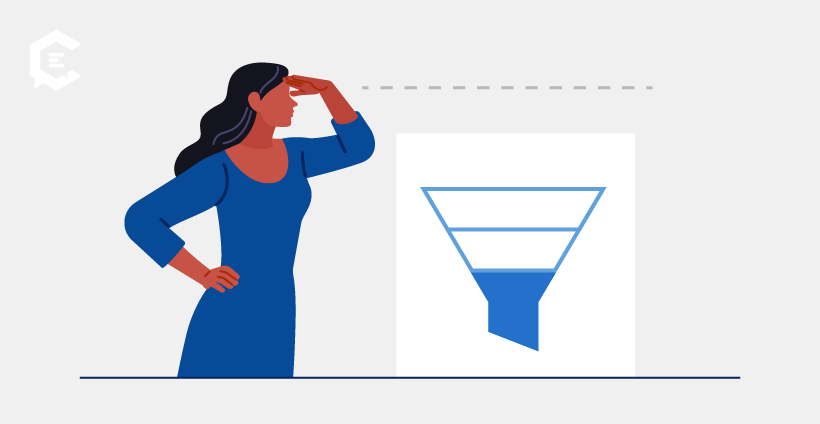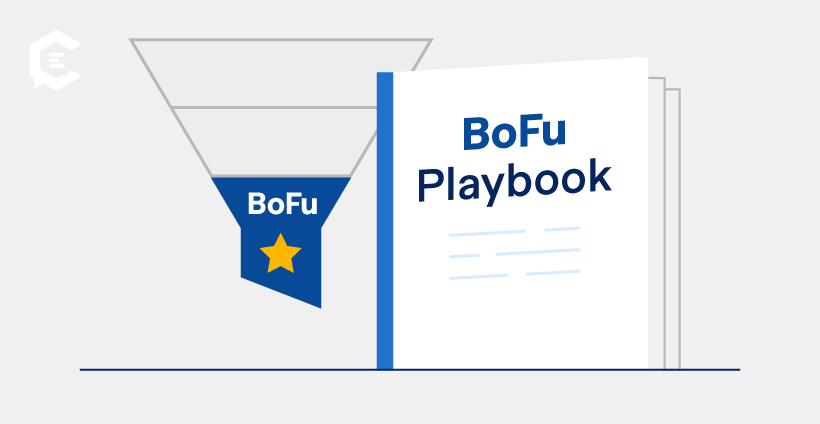Top-of-funnel (ToFu) content is everywhere — from podcasts discussing the latest industry trends to listicles highlighting the top tools for a certain task. But when consumers are ready to make a decision, bottom-of-funnel (BoFu) content that helps them buy products or services with confidence is surprisingly rare.
The result? Buyers disappear at the last mile. It’s not that people are uninterested in a product or service; they just don’t have the information they need to move forward. In this article, you’ll learn why BoFu content is often overlooked, what it actually does, and how to strengthen your BoFu content strategy and drive conversions.
Why Marketers Overlook Bottom-of-Funnel Content
What’s the reason behind this funnel imbalance? Why is there an overabundance of ToFu content, but scarcely any conversion-driven content? There are three main culprits:
1. Over-prioritization of awareness content
B2B content marketers mostly focus on assets that drive brand awareness. This makes sense because of how impactful content marketing can be at this stage of the buyer’s journey. Someone who’s seeking information about a certain topic could easily discover a new brand through a blog post explaining said topic.
The Content Marketing Institute found that 87% of B2B marketers have used content marketing to generate brand awareness in the past 12 months. In other words, they’re prioritizing top-of-funnel content like short articles and posts, with 92% of respondents producing these content types.
2. SEO-driven culture focused on ToFu keywords
Since B2B marketers are prioritizing content that will improve their visibility in relevant search results, ToFu keywords tend to dominate the SEO landscape. According to Backlinko’s analysis of the most popular Google searches in 2025, most keywords are either navigational or informational. Users are either looking for a specific site or want to learn something.
Marketers will create assets to match user search intent, which means they’re focusing more heavily on ToFu content.
3. Underestimation of BoFu’s role in conversions
Another reason for the imbalance in content funnel stages is that marketers may be underestimating the role of BoFu in driving conversions. They might rely too heavily on other methods, like consultations or cold calls, to convert their leads.
However, B2B buyers are still engaging with online content during their purchase journey. For example:
- Marketers are seeing the highest ROI from their website, blog, and SEO efforts.
- Thirty-seven percent of B2B buyers engage with a supplier’s website during the buying process.
- Thirty-five percent conduct an online search for suppliers.
Sales enablement content like interactive tools and product demos play an important role in the B2B purchase journey. Delivering high-quality BoFu content through mediums like these can have a strong impact on conversions.
What Bottom-of-Funnel Content Actually Does
Understanding BoFu’s role in the buyer’s journey is essential to making the most of this content type. Here’s a quick breakdown of what bottom-of-funnel content can do for your content strategy.
Supports late-stage decision making
During the final stage of the buyer’s journey, consumers often want to see how a product works or learn how others have benefited from it. Providing this information through BoFu content fills these knowledge gaps and gives buyers the clarity and confidence they need to make a purchase.
Connects product capabilities to pain points
A BoFu marketing strategy focuses on conversion-driven content that directly addresses specific customer pain points. This type of content demonstrates how your offering solves a problem, helping your audience visualize the value they could gain from buying your product or service.
Functions as sales enablement
BoFu content also supports your sales team, providing the sales enablement resources they need to effectively create conversions. Assets like comparison pages or case studies ensure prospects receive the right content at the right time, increasing the chance of a sale.
How BoFu Accelerates ROI
If you’re still not convinced of the business value of bottom-of-funnel content, let’s explore how it can accelerate ROI for your business.
Quicker time-to-revenue
Put another way, BoFu content attracts high-intent prospects. People at this stage of the sales funnel are very close to making a purchase. Time-to-revenue is much quicker compared with ToFu content, helping you get more value out of your investment.
Stronger attribution and measurability
BoFu content has clear and specific metrics for stronger attribution, which helps you effectively measure the impact of your strategy and find ways to optimize it.
For example, if your landing pages aren’t converting prospects, you may want to A/B test different elements to see what works best.
Higher close rates
Your BoFu content strategy engages audiences who are well aware of their problem and know the solution they need. They’re just looking for a little more information to finalize their decision. If your conversion-driven content is impactful enough, you’re likely to experience higher close rates compared with content from higher up in the funnel.
Common Mistakes in a BoFu Content Strategy
If you’re creating bottom-of-funnel content but you’re not seeing significant results, you might be making one of the following mistakes:
1. You’re treating BoFu like ToFu
If you’re creating BoFu content with the same info as your top-of-funnel content, don’t be surprised if it fails to convert. Educational and informative copy — while helpful — does nothing to answer the kinds of questions these late-stage buyers have. Instead, offer thorough information on why your product is the solution to their problem.
2. You’re not aligned with product or sales
Another common mistake is creating BoFu content that doesn’t align with your product or sales messaging. Sometimes businesses avoid positioning their product because they don’t want to sound pushy. All this does is confuse your audience about which product to choose or whether your product can even solve their problem. At this stage, consumers are looking for clarity, not fluff.
3. You’re underinvesting in BoFu
As mentioned previously, many businesses are investing too heavily in their top-of-funnel marketing strategy and spending most of their marketing dollars on awareness ads. This leaves them with limited resources to spend on BoFu content. Your ads and ToFu content may bring in some prospects, but if those prospects aren’t finding the content they need to guide their purchases, you’ll end up seeing fewer conversions.
Building a Strong BoFu Playbook
Building a strong BoFu content strategy is all about creating the right types of content that address the specific needs and pain points of your audience in the right cadence. Here are a few best practices to get started:
1. Decide on content formats
BoFu content is effective in many formats. Here are a few assets to consider creating:
- Case studies
- Comparison pages
- Customer stories/testimonials
- FAQ pages
- Pricing pages
- Product demos
- Product pages
- ROI calculators
- Webinars or explainer videos
These sales enablement content types showcase the value that your product or service can deliver and help your audience better understand it. Crafting impactful landing page content can also help you drive more conversions.
2. Create persona-aligned content
Each of your buyer personas will have different pain points and needs. For instance, while an individual user may enjoy the time-saving benefits of your product, larger teams may benefit from its collaboration features. Your BoFu content strategy should specifically address what each persona seeks in your product.
3. Collaborate among teams
Writing high-quality bottom-of-funnel content requires cross-team input from the start, not just during the review stage. Without early involvement from your product and sales team, your writers will face major revisions and churn out BoFu content that fails to connect product capabilities with customer needs.
Despite the need for connectivity and integrated knowledge, teams don’t often have the bandwidth to simultaneously tackle BoFu content. Even worse, the necessary information for this content is oftentimes scattered across teams and systems. This challenge is compounded when companies use AI tools in silos, rather than having a streamlined approach to content creation.
Lashay Lewis, founder of BOFU.ai, emphasized the importance of information consolidation — via a dashboard or some other framework — to organize the vital product or service information writers need. Gathering assets like product capabilities, customer pain points, sales insights, and competitive positioning before writers begin writing could significantly streamline the content creation process as a whole and create more effective BoFu content.
Bringing Balance to the Funnel
Balancing your content funnel stages is all about reassessing your current strategy and filling in the gaps. Are you missing out on opportunities to create BoFu content that seamlessly aligns with your other content funnel stages? If so, ramp up your content creation efforts to focus on strategic, conversion-driven content.
If your funnel feels top-heavy, ClearVoice can help you rebalance with a strategy tailored to conversions. Our managed content creation services help you scale your content production while aligning it with your business goals at every stage of the funnel.
Connect with a content specialist today to get started.






